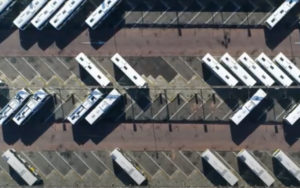One of the first offerings from the newly created Hitachi ABB Power Grids joint venture brings a “holistic” approach to large-scale charging

Source: Hitachi ABB
One of the first offerings from the newly created Hitachi ABB Power Grids joint venture brings a “holistic” approach to large-scale charging
As charging demands of large-scale public and commercial electric bus fleets grow, operators will need more efficient and scalable charging systems. One such solution was recently unveiled by Hitachi ABB Power Grids.
More than 2.3 million municipal electric buses will be in service by 2040, up from 400,000 today, according to a company statement. To meet this demand, Hitachi ABB Power Grids — a joint venture finalized in July, in which Hitachi has an 80 per cent stake — has rolled out a grid-to-plug charging system called Grid-eMotion Fleet.
“New technology solutions are required to enable an effective deployment of charging infrastructure to serve mass electrification of e-mobility,” says a product video from the company.
Integrated units
The system uses DC technology and is packaged in containers that integrate the grid connection and charging system into one unit.
Unlike AC-DC charging networks, which may require a lot of infrastructure and equipment, Grid-eMotion is a “step-change approach” in EV charging, the company says. It takes up 60 per cent less space, has 40 per cent less depot cabling, and can connect to any type of power grid.
“The Grid-eMotion Fleet launch is a game-changer for anyone managing public transport and commercial EV fleets,” says Niklas Persson, managing director of the grid integration business unit at Hitachi ABB Power Grids. “Grid-eMotion Fleet delivers unprecedented scalability, space savings and operational efficiency.“
Additionally, the Grid-eMotion system also uses Hitachi’s e-mesh energy management software, an asset management system that determine a bus’s energy consumption and collects data on details like battery life, routes and traffic simulations, to help the service run more effective and efficiently, while also helping reduce carbon footprints.
“The solution will accelerate the global uptake of safe, sustainable and smart mobility, whilst contributing to cleaner air and an enhanced quality of life for today’s generation and those to come,” says Persson.






